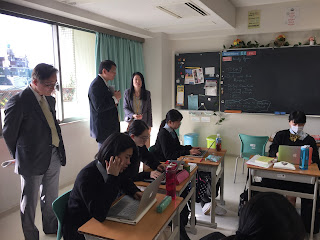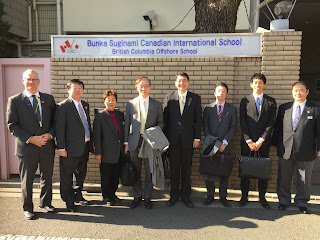We were thrilled this last weekend to explore a corner of Nagano prefecture that, much to our relief, is quite rural. We found there some of the texture, people and conversations that helped us understand a whole part of Japan we have not really been able to access before.
Our weekend started with a stay at a wonderful Airbnb owned by an American and his Japanese wife. They are both artisans who bought an old traditional house as well as an abandoned silk production warehouse and turned them into a very tasteful guesthouse and craft exhibit space. We were struck by the beauty of blending the simple lines of Japanese construction and taste with artist's taste for simple craft hangings on the wall.

We were visiting Tei, one of our friends who is of Japanese, American roots who chose to come back to Japan and make a life for herself in this little hamlet tucked high in the hills. (Here she is with one of her neighbors who runs a Tibetan health clinic after spending ten years learning Tibetan and training in Tibetan traditional medicine).

After living fifteen years renting an old, ramshackle, fascinating farm house she was able to buy the house and land. She currently travels twice a week to teach classes at two of the universities here.

Like in Europe the houses are often tucked closely together with the fields spread around the hills above. Her neighbour's house is also a beautiful old farmhouse... abandoned and slowly being taken over by vines. Behind her is "God mountain", in front "Goddess mountain".
As a break from Tokyo we totally enjoyed exploring her valley in the peace of a late fall weekend. The local temple was quite magical with its' simple illuminations at night:
And in the daytime...
We are always fascinated by the Japanese form of graffiti; hundreds of peoples' name on paper strips glued to the temple entrance.
In the morning we went to pay our respects to the local water god and fill up two containers of the purest water in the valley.
Looking back through the Tori gate you get a sense of the serenity of this little nook... with the endless urban sprawl in the valley bottom.
Tei took us to her favorite temple where the priest is one of her good friends.
We had an afternoon walk through the forest and the fall leaves, totally enjoying the variety of mini-shrines and statuettes tucked in the forest. Some of them were actually burial stones for horses of a hundred or so years ago while others were for the hearing god where you should rub a stone on the ears.
During our walk in the woods we stopped at another friend's house to learn more about the valley. This gentleman had worked as an engineer with Harley Davidson in the Mid-West USA and has now bought this house in her valley. He is carefully restoring this old farm house with traditional building techniques.
Some of the fascinating traditional techniques include using twine instead of nails to fix the rafters to permit mobility during earthquakes without the roof collapsing.
Check out the "Wabi-sabi" beam here:
We also continued to glory in the many expressions of Buddhist and Shinto faith all around this valley.
The small shrine, probably to children, laden with toy offerings:
The ancient many level tower that withstood hundreds of years of earthquakes:
And the unique and vibrant details to be found at every site:
With a bit of regret we descended down to the valley of Ueda with the usual intense intertwining of power lines, railroads, tunnels, freeways, roads, malls and housing to catch the train home. We had the opportunity for a quick visit to Ueda castle, one of the great samurai castles of Japanese history. People still visit this site to honour the wisdom of the Sanada samurai clan. See here for more details.
With the sunset arriving and the train station beckoning (among the many floors of neon lights, the crowds, the buses and cars and the dozens of restaurants) we returned to Tokyo with a bit more of a personal sense of rural, back to the land life in Japan.














































